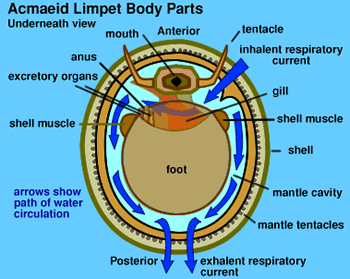|
|
Biological Factors
Excretion
In the process of absorbing food, all creatures create poisonous waste products that must be got rid of. Getting rid of poisonous waste products is important to the survival of all animals. Sea creatures, which are submerged for long periods of time, use the water swirling around them to carry away the waste products of digestive processes.

One unusual feature found in molluscs is that during the early developmental stages of growth each mollusc's body undergoes a process called torsion. The body twists around so that the anus and reproductive organs come to rest above the head. This sounds bizarre, but has an important function.
The incoming fresh current of water firstly passes the gills where the oxygen is extracted and carbon dioxide released into the water. The water then passes the excretory organs and then the anus before flowing around the channel in the mantle cavity to leave the shell at the rear or posterior.
Question:
What are the advantages of this design ?
References
Bennett, I. (1987) W. J. Dakin's classic study: Australian Seashores. Angus & Robertson, Sydney.
Davey, K. (1998) A Photographic Guide to Seashore Life of Australia. New Holland, Sydney.
Underwood, A. J. & Chapman, M. G. (1993) Seashores: a beachcomber's guide. New South Wales University Press, Sydney.
Biological
Factors
Oxygen & Respiration
Food and Predation
Excretion
Reproduction
Behaviour
 Life
on Australian Seashores
Life
on Australian Seashores
by Keith Davey (C) 2000
Learning Consultant
- Media
The University of Newcastle
email at australian_seashores@hotmail.com
Scientific Consultant: Phil
Colman
site created 01.01.98 : updated 01.04.2000
